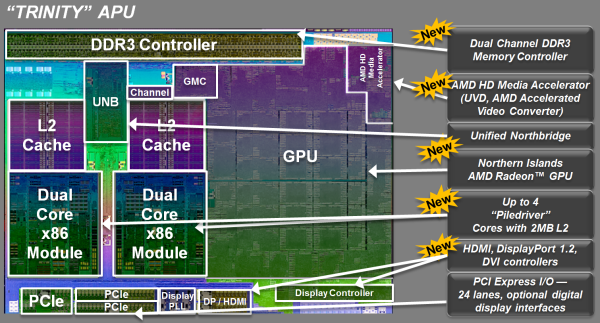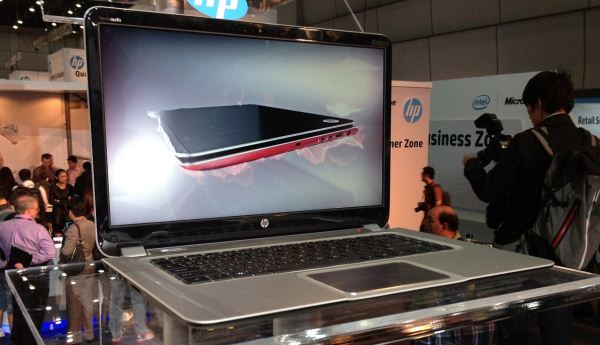The AMD Trinity Review (A10-4600M): A New Hope
by Jarred Walton on May 15, 2012 12:00 AM ESTConclusion: What Makes a Trinity?
I have often wondered about where AMD came up with the codename Trinity (other than the river name, of course). Was it a reference to this being AMD’s third APU? Or maybe AMD was gunning for the Holy Trinity of Performance, Battery Life, and Cost—get wins in all three areas and you’d have a guaranteed best seller! If that’s what AMD was hoping to accomplish, they’ve got a good foundation but we’ll need to see what the laptop OEMs come up with before issuing a final verdict.
To recap, Trinity is AMD’s continued journey down the path they started with Llano. Both CPU and GPU performance have improved over Llano. The general purpose CPU performance gap vs. Intel is somewhere in the 20—25% range, while the GPU advantage continues to be significantly in AMD's favor. It is surprising that Intel's HD 4000 is able to win even in some tests, but overall AMD continues to deliver better GPU performance even compared to Ivy Bridge. It's worth pointing out that the concerns about AMD's battery life from a few years ago are now clearly put to rest. At least at the TDPs we've tested, AMD is easily competitive with Intel on battery life.
AMD's GPU accelerated software lineup this time around is significantly better than it was with Llano, but we're still not quite where we need to be yet. I will hand it to AMD though, progress is clearly being made. Battery life is generally a step forward vs. Llano, which is more than we've been able to say about Ivy Bridge thus far.
The improvements in Piledriver really appear to have saved Trinity. What was a very difficult to recommend architecture in AMD's FX products has really been improved to the point where it's suitable for mobile work. AMD couldn't push performance as aggressively as it would have liked given that it's still on a 32nm process and the APU needs to make money. A move to 2x-nm could help tremendously. Similarly the move to a more efficient VLIW4 GPU architecture and additional tuning helped give AMD a boost in GPU performance without increasing die size. Overall, Trinity is a very well designed part given the process constraints AMD was faced with.
As a notebook platform, Trinity's CPU performance isn’t going to set any new records but it’s certainly fast enough for most users; battery life isn’t at the head of the class, but it’s better than just about anything that doesn’t qualify as an ultrabook; and finally there’s the question of cost. That last item isn’t really in AMD’s control, as the final cost of a laptop is a product of many design decisions, so let’s do some quick investigation into laptop pricing.
If you figure on memory, motherboard, chassis, LCD, and storage as all being the same, a typical laptop will have a starting price point of around $300—for a cheap, injection molded plastic shell, 4GB RAM, a 5400RPM HDD, a 1366x768 TN panel, and a no-frills feature set. Take that same basic platform and you can make an Intel laptop and have a BoM (Bill of Materials) cost of around $450, or you can make an AMD laptop and your BoM might start at $400. Depending on what other upgrades an OEM makes, as well as marketing, R&D, and profit, and we end up at a final price tag that might be $600 for a Trinity laptop compared to $700 for an Ivy Bridge laptop. The problem is that AMD doesn't just compete against vanilla Ivy Bridge; it has to compete against all the existing laptops as well.
Right now, Llano A8 laptops at Newegg have a starting price of $480 for an A8-3500M Acer Aspire, and they range up to $700 for a 17.3” HP dv7. The highest performance laptop of the bunch is probably Samsung’s Series 3, which uses an A8-3510MX APU and goes for $680. I suspect we’ll see similar pricing for Trinity laptops. On the Sandy Bridge Core i3/i5 side of the fence, Newegg has a much larger selection of laptops, starting at $430 for a Lenovo G570, $550 for the cheapest Core i5 model (again from Acer), and going up to $680 or more for laptops with Core i5 and NVIDIA Optimus graphics. Or if you prefer some place other than Newegg, you can find Core i5-2450M with GT 540M in Acer’s AS4830TG for $600.
That pretty much defines the maximum price we should expect people to pay for Trinity, as Core i5 with Optimus will deliver better CPU and GPU performance based on our test results. Obviously there are other factors to consider, like build quality of the laptop(s), display quality, battery life, and features, but most people shopping for an inexpensive laptop are going to be looking at cost first and features second. On the other hand, if you want style as a consideration, HP’s new sleekbooks will have Trinity versions starting at $600 for 15.6” and $700 for 14”—though it’s not clear which APU you’ll get at those prices. As long as last-generation Sandy Bridge laptops are at clearing house prices, though, AMD’s partners are going to need to be under $600 for something like the A10-4600M laptop we’re reviewing today. Assuming they can manage that, Trinity should see plenty of volume with the back to school season coming over the next few months.
For those who are interested in more than just the bottom line, as usual the best laptop for you may not be the best laptop for everyone. Trinity in a 14” form factor like our prototype would make for a great laptop to lug around campus for a few years. It would be fast enough for most tasks, small enough to not break your back, battery life would be long enough to last through a full day of classes, and the price would be low enough to not break your bank. And if mom and dad are footing the bill, you even get to disguise the fact that it’s a gaming capable laptop by not having a discrete GPU specifically called out on the features list. On the other hand, if you’re after a higher performance laptop or you want a “real” gaming system—something that can hand high detail settings at 1600x900 for instance—your best bet continues to be laptops with an Intel CPU and a discrete GPU from NVIDIA, at least of the GT 640M level—I’d say AMD GPUs as well, but I’m still waiting for a better switchable graphics solution.
At this point, AMD has done everything they can to provide a compelling mobile solution. The difficulty is that there's no longer a single laptop configuration that will be "best" for everyone, and Trinity only serves to further muddy the water. Intel continues to offer better CPU performance, and if you need graphics—which mostly means you want to play games—they have a good partner with NVIDIA. AMD on the other hand is delivering better integrated graphics performance with less CPU power, and depending on what you want to do that might be a more well rounded approach to mobile computing. What we need to see now are actual laptops and their prices. To trot out a tired old saying once more, "There are no bad products; only bad prices." Now it's up to AMD's partners to make sure Trinity laptops are priced appropriately.












271 Comments
View All Comments
Wierdo - Tuesday, May 15, 2012 - link
I'll start recommending an integrated Intel GPU once I feel more confident about their driver support, which is more important than performance.At least now the IGP in Ivy Bridge is a decent solution for basic gaming needs, but they really need to work on their drivers, no more of that "driver update five years after product is obsolete" bs.
Spunjji - Wednesday, May 16, 2012 - link
I agree, although even that seems to have improved somewhat; at least from the base standard of "what works to begin with". Here's hoping for further progress.medi01 - Wednesday, May 16, 2012 - link
Except there is one thing which isn't visible on charts: quality. Check how horrible Intel's AF is on toms Trinity review.fumigator - Tuesday, May 15, 2012 - link
"AMD still has better drivers than Intel, but it's more like 20% better "Unluckly I had an Ivy Bridge HD4000 notebook sitting for a week, and out of 29 games, only 60% were barely playable (performance), 15% crashed, and the rest run with strange artifacts but stable enough though.
While I don't worry alot about gaming in a laptop, the true fact is that intel is way behind AMD in this, and we are not talking about 3D render quality. Oh my, you have to take a look at that and you won't doubt it a second. AMD and Nvidia renders are better.
While I still hoped more from trinity, not sure to make a judgement until I grab one and put a decent super fast ram module on it and go testing.
JarredWalton - Tuesday, May 15, 2012 - link
Could you please provide a list of the games that were unplayable and those that crashed? I'd love to be able to confirm problems.frozentundra123456 - Tuesday, May 15, 2012 - link
The gpu is "several orders of magnitude" better than intel's best? You do realize that an order of magnitude is 10x right? So how many orders of magnitude better 2, 3, 4 (100x, 1000x, 10000x). Overstate much?In fact trinity is on average what, 20-30% better than HD4000? Hardly one order of magnitude much less multiple orders of magnitude.
Overall the chip is OK, but I was actually hoping for more improvement on the GPU side. Yes, it is improved, but not enough to really make a game go from unplayable to playable.
BSMonitor - Tuesday, May 15, 2012 - link
Most laptops from that time did not use Intel's IGP on the chipset. Most had AMD or nVidia dGPU's. And these new Trinity APU's probably compete pretty closely to that.RussianSensation - Tuesday, May 15, 2012 - link
Core 2 Duo came out in 2006 not 2004.Intel doesn't sell Core 2 Duo laptops anymore in mainstream segments. They sell IVB laptops.
Are you implying that C2D user will want to upgrade to Trinity?
Most users would be far better off getting an Intel laptop with low end Kepler GPU such as GT640 than this.
Lugaidster - Tuesday, May 15, 2012 - link
Assuming equal pricing sure. But there's no way an IVB with a low end Kepler will be near a trinity laptop in terms of pricing. Most likely it will be a few hundred dollars more, which depending on the target, can make a difference.Sure you can recommend that, but not everyone will see that as worth the extra couple of hundred dollars. Considering that aside from CPU performance, a trinity notebook is roughly equal to an IVB one, with price in their favour, they can sell lots of these.
JarredWalton - Tuesday, May 15, 2012 - link
I expect we'll see dual-core IVB with Kepler going for around $800-$850 at the low end of the scale. I also expect we'll see a lot of the early Trinity laptops with A10-4600M selling for closer to $700. Hopefully I'm wrong on the Trinity side, but they did the same thing with Llano. "It's new! Charge more for it!" Not AMD's fault at all, obviously, but still irritating.